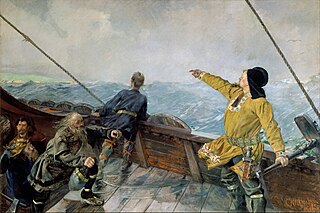
Adam of Bremen was a German medieval chronicler. He lived and worked in the second half of the eleventh century. Adam is most famous for his chronicle Gesta Hammaburgensis ecclesiae pontificum. He was "one of the foremost historians and early ethnographers of the medieval period".

German literature comprises those literary texts written in the German language. This includes literature written in Germany, Austria, the German parts of Switzerland and Belgium, Liechtenstein, Luxembourg, South Tyrol in Italy and to a lesser extent works of the German diaspora. German literature of the modern period is mostly in Standard German, but there are some currents of literature influenced to a greater or lesser degree by dialects.

Theodoric is a Germanic given name. First attested as a Gothic name in the 5th century, it became widespread in the Germanic-speaking world, not least due to its most famous bearer, Theodoric the Great, king of the Ostrogoths.
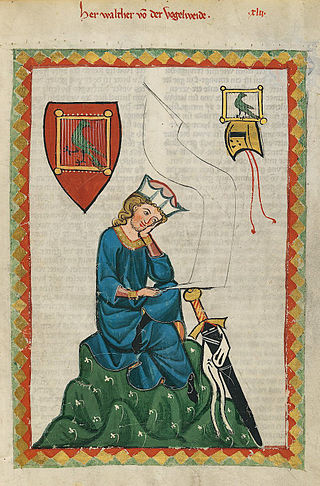
Minnesang was a tradition of lyric- and song-writing in Germany and Austria that flourished in the Middle High German period. This period of medieval German literature began in the 12th century and continued into the 14th. People who wrote and performed Minnesang were known as Minnesänger, and a single song was called a Minnelied.
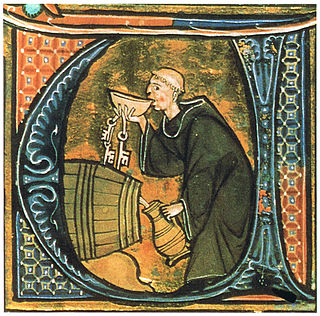
The Archpoet, or Archipoeta, is the name given to an anonymous 12th-century author of ten medieval Latin poems, the most famous being his "Confession" found in the Carmina Burana manuscript. Along with Hugh Primas of Orléans, he is cited as the best exemplar of Goliardic poetry and one of the stellar poets of the Latin Middle Ages.

Old High German is the earliest stage of the German language, conventionally identified as the period from around 500/750 to 1050. Rather than representing a single supra-regional form of German, Old High German encompasses the numerous West Germanic dialects that had undergone the set of consonantal changes called the Second Sound Shift.
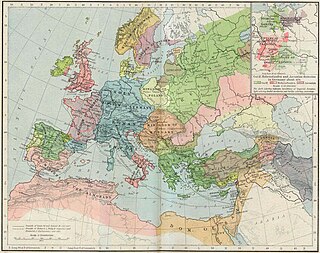
The High Middle Ages, or High Medieval Period, was the period of European history that lasted from AD 1000 to 1300. The High Middle Ages were preceded by the Early Middle Ages and were followed by the Late Middle Ages, which ended around AD 1500.

Medieval Latin was the form of Literary Latin used in Roman Catholic Western Europe during the Middle Ages. In this region it served as the primary written language, though local languages were also written to varying degrees. Latin functioned as the main medium of scholarly exchange, as the liturgical language of the Church, and as the working language of science, literature, law, and administration.

Romantic poetry is the poetry of the Romantic era, an artistic, literary, musical and intellectual movement that originated in Europe towards the end of the 18th century. It involved a reaction against prevailing Enlightenment ideas of the 18th century, and lasted approximately from 1800 to 1850. Romantic poets rebelled against the style of poetry from the eighteenth century which was based around epics, odes, satires, elegies, epistles and songs.
The Ezzolied, also known as the Cantilena de miraculis Christi or the Anegenge (Beginning), is an early Middle High German poem written in the 1060s by Ezzo, a German scholar and priest of Bamberg. It is the first poetic text of the High Middle Ages to join German vernacular and Latin learning.

Z with hook, Ȥ is a letter of the Latin script.
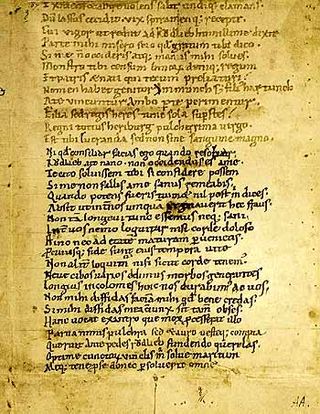
Ruodlieb is a fragmentary romance in Latin verse written by an unknown southern German poet who flourished about 1030. He was almost certainly a monk of the Bavarian Tegernsee Abbey.
Baghdadi or Al-Baghdadi may refer to:
Middle High German literature refers to literature written in German between the middle of the 11th century and the middle of the 14th. In the second half of the 12th century, there was a sudden intensification of activity, leading to a 60-year "golden age" of medieval German literature referred to as the mittelhochdeutsche Blütezeit. This was the period of the blossoming of Minnesang, MHG lyric poetry, initially influenced by the French and Provençal tradition of courtly love song. The same sixty years saw the composition of the most important courtly romances. again drawing on French models such as Chrétien de Troyes, many of them relating Arthurian material. The third literary movement of these years was a new revamping of the heroic tradition, in which the ancient Germanic oral tradition can still be discerned, but tamed and Christianized and adapted for the court.
Old High German literature refers to literature written in Old High German, from the earliest texts in the 8th century to the middle of the 11th century.
In the Middle High German (MHG) period (1050–1350) the courtly romance, written in rhyming couplets, was the dominant narrative genre in the literature of the noble courts, and the romances of Hartmann von Aue, Gottfried von Strassburg and Wolfram von Eschenbach, written c. 1185 – c. 1210, are recognized as classics.










